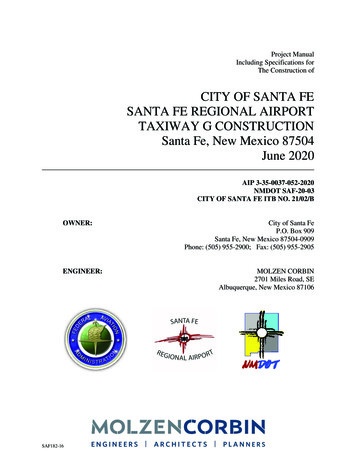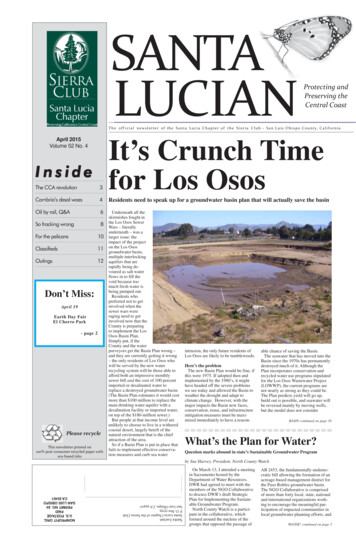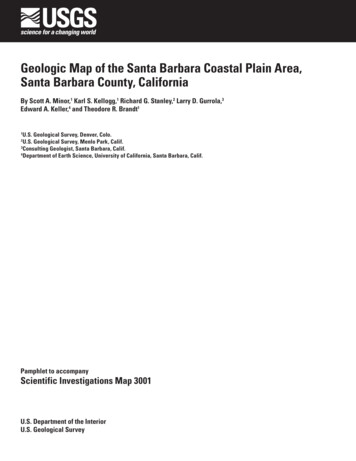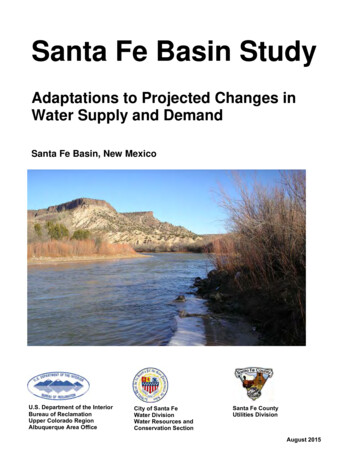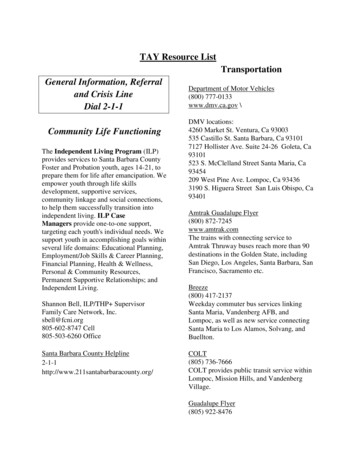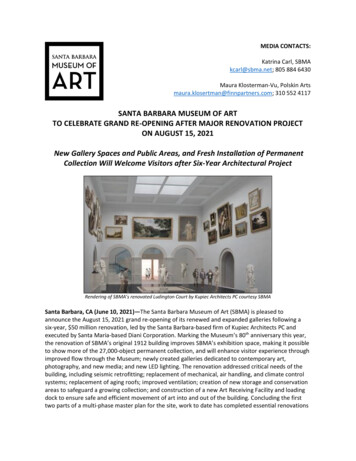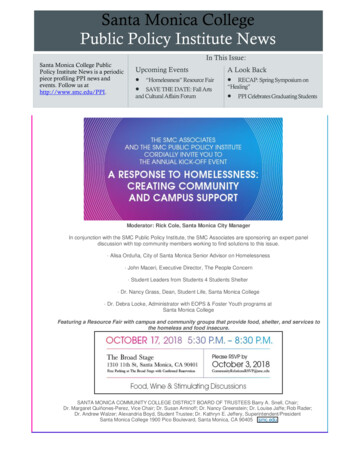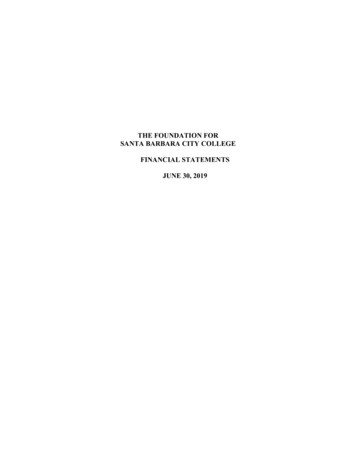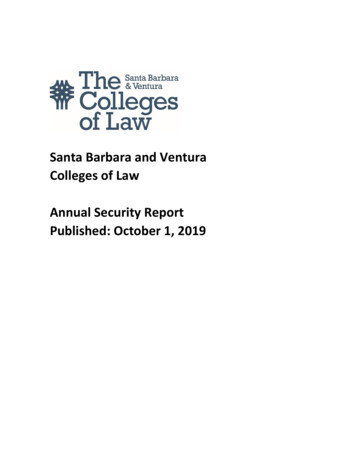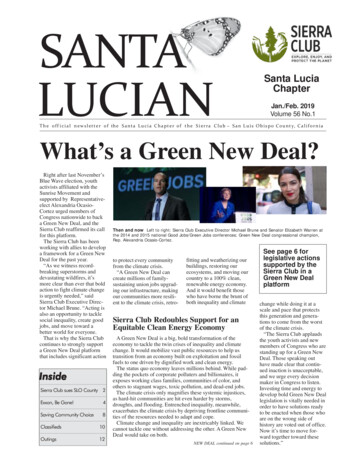
Transcription
1Santa Lucian Jan./Feb. 2019SANTALUCIANSanta LuciaChapterJan./Feb. 2019Volume 56 No.1T h e o f f i c i a l n e w s l e t t e r o f th e S a n t a L u c i a C h a p t e r o f t h e S i e r ra C l u b S a n L u i s O b i s p o C o u n t y, C a l i f o r n i aWhat’s a Green New Deal?Right after last November’sBlue Wave election, youthactivists affiliated with theSunrise Movement andsupported by Representativeelect Alexandria OcasioCortez urged members ofCongress nationwide to backa Green New Deal, and theSierra Club reaffirmed its callfor this platform.The Sierra Club has beenworking with allies to developa framework for a Green NewDeal for the past year.“As we witness recordbreaking superstorms anddevastating wildfires, it’smore clear than ever that boldaction to fight climate changeis urgently needed,” saidSierra Club Executive Director Michael Brune. “Acting isalso an opportunity to tacklesocial inequality, create goodjobs, and move toward abetter world for everyone.That is why the Sierra Clubcontinues to strongly supporta Green New Deal platformthat includes significant actionInsideSierra Club sues SLO County 2Exxon, Be Gone!4Saving Community Choice8Classifieds10Outings12Then and now Left to right: Sierra Club Executive Director Michael Brune and Senator Elizabeth Warren atthe 2014 and 2015 national Good Jobs/Green Jobs conferences; Green New Deal congressional champion,Rep. Alexandria Ocasio-Cortez.to protect every communityfrom the climate crisis.“A Green New Deal cancreate millions of familysustaining union jobs upgrading our infrastructure, makingour communities more resilient to the climate crisis, retro-fitting and weatherizing ourbuildings, restoring ourecosystems, and moving ourcountry to a 100% clean,renewable energy economy.And it would benefit thosewho have borne the brunt ofboth inequality and climateSierra Club Redoubles Support for anEquitable Clean Energy EconomyA Green New Deal is a big, bold transformation of theeconomy to tackle the twin crises of inequality and climatechange. It would mobilize vast public resources to help ustransition from an economy built on exploitation and fossilfuels to one driven by dignified work and clean energy.The status quo economy leaves millions behind. While padding the pockets of corporate polluters and billionaires, itexposes working class families, communities of color, andothers to stagnant wages, toxic pollution, and dead-end jobs.The climate crisis only magnifies these systemic injustices,as hard-hit communities are hit even harder by storms,droughts, and flooding. Entrenched inequality, meanwhile,exacerbates the climate crisis by depriving frontline communities of the resources needed to adapt and cope.Climate change and inequality are inextricably linked. Wecannot tackle one without addressing the other. A Green NewDeal would take on both.NEW DEAL continued on page 6See page 6 forlegislative actionssupported by theSierra Club in aGreen New Dealplatformchange while doing it at ascale and pace that protectsthis generation and generations to come from the worstof the climate crisis.“The Sierra Club applaudsthe youth activists and newmembers of Congress who arestanding up for a Green NewDeal. Those speaking outhave made clear that continued inaction is unacceptable,and we urge every decisionmaker in Congress to listen.Investing time and energy todevelop bold Green New Deallegislation is vitally needed inorder to have solutions readyto be enacted when those whoare on the wrong side ofhistory are voted out of office.Now it’s time to move forward together toward thesesolutions.”
2Santa Lucian Jan./Feb. 2019Sierra Club Sues County to Uphold Land Use LawIn 2017, The Fesler FamilyTrust applied for unconditional certificates of compliance that would create twelveland parcels on the FeslerRanch in rural ArroyoGrande, based on an antiquated subdivision map from1905.County Planning replied:“[T]here were no laws ineffect at that time thatregulated design and improvement. Therefore, we arerequired to deny yourapplication for issuance oftwelve unconditional certificates of compliance for theselots.”Fesler appealed the denialto the County Board ofSupervisors. On October 2,2018, the majority of theBoard , Peschong (D1),Compton (D4), and Arnold(D5), voted to approve anantiquated subdivision inviolation of state law. (See“Antique Land Use Planningat Its Finest,” Sept./Oct.)In so doing, they overrodetheir Planning Department’sdenial of the application andignored the advice of theirown legal counsel, whoclearly articulated current lawsupporting the CountyPlanning Department’soriginal conclusion that thelots in question are “notseparate legal parcels recognized under today’s Subdivision Map Act.”With 4th District SupervisorLynn Compton leading thecharge, the Board majorityupheld the appeal and took abig step toward tossing outthe rules on local land use andinviting an unregulatedstampede of development.Antiquated subdivisionsinevitably compromise futurelivability.They: disregard the general planand applicable specific plans do not conform with landuse ordinances fail to coordinate planningwith the established localpattern and assureproper improvementsare made cause incompatible landuses are detrimental to regionaleconomies lack adequate infrastructureto support development fail to consider ancillaryservices needed for development (schools, parks, fire,police).Help support livablecommunitiesThe board’s decision hasopened the door to a terribleprecedent. If you live in anyrural or semi-rural area of SanLuis Obispo County, the oddsare there is an antiquatedsubdivision near you. If theCounty’s approval stands, theprecedent will be set and theLAWSUIT continued next pageSanta LucianAndrew ChristieEDITORLindi DoudEDITORIAL COMMITTEEDenny MynattPRINT MEDIA COORDINATORThe Santa Lucian is published six times a year. Articles, environmental informationand letters to the editor are welcome. The deadline for each issue is the 13th of theprior month.send to: Editor, Santa Lucian, Sierra Club, P.O. Box 15755, San Luis Obispo, CA93406. sierraclub8@gmail.comSanta Lucia Chapter2019 Executive CommitteeSue Harvey (12/19) CHAIRCarmen Bouquin (12/21) MEMBERChuck Tribbey (12/19) MEMBERHeather Howell (12/20) MEMBERViolet Cavanaugh (12/20) MEMBERNancy Cole (12/20) MEMBERJennifer Bauer (12/21) VICE-CHAIRThe Executive Committee meetsthe third Wednesday of each monthat 4:15 p.m. in the chapter office,located at 974 Santa Rosa St., SanLuis Obispo. All members arewelcome to attend.Chuck Tribbey COUNCIL OF CLUB LEADERSKevin O’Gorman TREASURERCommitteesPoliticalViolet CavanaughJennifer BauerMembership/DevelopmentOpenConservationSue HarveyNuclear Power Task ForceRochelle BeckerLinda SeeleyCA Conservation CommitteedelegatesJennifer Bauer, Violet CavanaughCalendar SalesOpenOutingsFacebook AdministratorKim RamosBookkeeperSandra CiriloOutingsBill WaycottWebmasterMonica TarzierTrail GuideGary FelsmanChapter DirectorAndrew Christie sierraclub8@gmail.comSanta Lucia ChapterP.O. Box 15755San Luis Obispo, CA 93406805-543-8717Office hours Monday-Friday,1:30 p.m. - 7 p.m.974 Santa Rosa StreetSan Luis ObispoPrinted by University Graphic Systems Cal Poly, San Luis ObispoMailing preparation services courtesy of the Silver Streaks
3Santa Lucian Jan./Feb. 2019Lawsuitcontinued from page 2problems listed here arelikely to start appearing inyour back yard.The Santa Lucia Chapter ofthe Sierra Club is defendingyour quality of life by legallychallenging this irresponsibleaction in court.“That’s going to openup a door for more thanjust Mr. Fesler.”- Assistant County CounselTim McNulty on the Boardmajority’s decision to createland parcels in violation ofstate lawWe must send a clear message to the boardof supervisors. If the county’s action stands,the many owners of antiquated subdivisionscreated before the advent of modern land usepolicies will demand that their maps bedeclared valid, providing an end run aroundthe requirements of the county’s GeneralPlan to the great detriment of rural lands. Weare seeking to head off that outcome and tocheck the arrogantly unlawful actions of theSLO County Board majority.Want to support our public interest litigation, conservation campaigns and outreach?It’s tax-deductibleBecause the Sierra Club engages in political advocacy, donations to the Sierra Club are usually not tax-deductible. Butyou can help fund the charitable part of our chapter’s work, including public interest litigation, conservation campaigns,and public education, and make your donation tax-deductible by making out your check to The Sierra Club Foundationand sending to Sierra Club, P.O. Box 15755, San Luis Obispo, CA 93406. (Write “Santa Lucia Chapter” in the Memosection.)For a tax-deductible credit card donation, you can just send us a note with the name on the card, amount to be donated,your credit card number, expiration date, and signature. (Write “Foundation Deposit” at the top.)We look forward to partnering with you in 2019 to protect the SLO Coast we know and love.The Next 50 YearsOn October 27, the SLO Botanical Garden hosted“A Garden of Earthly Delights,” the 50th anniversarycelebration of the Santa Lucia Chapter of the SierraClub.A good time was emphatically had by all, whetherchecking out the silent auction items and loading upon goodies provided by Something’s CookingCatering , participating in the live auction, or rockingout to the Back Pages Band.Welcome, guest Chapter Chair Chuck Tribbey (left) chats with California Secretaryof Resources John Laird, who spoke with event set-up volunteers from the Cal PolyEnvironmental Council during their pizza break.Organizers Jennifer Von DerLohe, Wanda McDonald andDawn Annoni did a fantasticjob, donated auction itemswere spectacular, and the food,beer, wine, music and magicmade it a great day!and: Christine MulhollandWith thanks to our sponsors:Carla SaundersDeborah CashKurt KupperSusan & Richard HarveyDavid & Naomi BlakelyPaul Meagher on behalf of SunWork
4Santa Lucian Jan./Feb. 2019It’s Time to Say:Exxon, Be GoneIf we defeat these proposals,we have a chance of keepingthis oil in the ground andmarking the beginning of theend of offshore oil inCalifornia.Plains All-American Pipeline caused the Refugio Oil Spill of 2015, California’s worst coastal oil spill in25 years. Now it wants another chance to spill again.A history of violationsInvestigators responding toa massive coastal oil spill nearRefugio State Beach in 2015found the source, PlainsPipeline 901, to be severelycorroded and poorly maintained. In September 2018, aSanta Barbara jury foundPlains guilty of a felony forfailing to properly maintainits pipeline and eight misdemeanor charges for a delay inreporting the spill and for itsdeadly impact on protectedwildlife. The jury concludedthe company knew or shouldhave known that its pipelinewas corroded and about tofail.Plains All AmericanPipeline had a bad safetyrecord even before theRefugio spill. Federal recordsshow the company had 175incidents from 2006-2015,most of them oil spills,including 11 in California.Federal enforcement actionswere launched against thecompany 20 times during thatperiod, many for corrosioncontrol and maintenanceproblems on its pipelines.Federal data show oilpipelines are dangerous andprone to failure, particularlywhen they’re either old orbrand new, the latter oftenbecause of faulty welds. From1986-2015, there were nearly8,000 serious pipeline breaksin the U.S., causing more than2,300 injuries and nearly 7billion in property damage.More than a third of thosewere from corrosion or otherspontaneous failures.Six offshore drillingplatforms – ExxonMobil’sPlatforms Harmony, Heritageand Hondo; and FreeportMcMoRan’s PlatformsHarvest, Hermosa andHidalgo – were all idled byPlains’ 2015 pipeline failure.The new pipeline could restartoil production, prolong thelifespan of aging offshoreinfrastructure, and serve newoffshore drilling planned bythe Trump administration.The Trump administration isproposing to offer the firstnew fossil fuel leases infederal waters off Californiain more than 30 years.Hundreds of new offshorewells could be drilled incoming years.The 2015 Plains Pipeline oilspill blackened Santa Barbaraarea beaches for miles andkilled hundreds of birds andmarine mammals, including atleast 74 California sea lions.Even larger spills are possibleonce the project reactivateslong-dormant offshore platforms and pipelines.Allowing drilling in federalwaters off Southern Californiato resume and expand wouldlikely result in hundreds of oilspills that would harm California sea otters, blue whalesand other animals vulnerableto Pacific drilling. Resumingoffshore fracking wouldfurther dirty our oceans andharm marine life.AntandrusSanta Barbara County isprocessing Plains’ applicationto build another coastal oilpipeline that would restartdrilling from six decrepitoffshore oil platforms in theSanta Barbara Channel.Houston-based Plains wascriminally negligent inallowing its previous coastaloil pipeline to becomecorroded and fail, coatingSanta Barbara area beaches incrude and killing hundreds ofbirds and marine mammals. Itdoesn’t deserve anotheropportunity to kill threatenedwildlife, poison our communities and wreck the climate.Plains All AmericanPipeline is proposing to buildmore than 123 miles of newoil pipeline through SantaBarbara (73 miles), San LuisObispo (37 miles) and Kerncounties (14 miles), transporting heavy crude pumped fromoffshore drilling platforms toonshore processing facilities.Plains also proposes toabandon in place about 123miles of its old failed oilpipelines.The new pipeline willmostly follow the same routeas the old broken pipeline –which was built based onenvironmental studies done inthe late ‘80s – in a rapidlychanging coastal zone that isnow being affected by coastalerosion, sea level rise andother impacts from climatechange.How FarShould YouTrust an OilCompany?As far as you can toss a tankerAt 11:59 a.m. on Tuesday,Nov. 6, as SLO County voterswere going to the polls to voteon Measure G, the ballotinitiative designed to protectthe county’s aquifers fromexpanded oil field operationsand keep fracking and other“enhanced” oil extraction methods out of the county, the California Division of Oil, Gas, and Geothermal Resources let it beknown that it was “considering a proposal to exempt the MidwaySunset Oil Field, located in Kern County and San Luis ObispoCounty, CA. Subject to approval by the United States EnvironmentalProtection Agency, the proposed aquifer exemption would allow theState, in compliance with the federal Safe Drinking Water Act, toTRUST continued next page
5Santa Lucian Jan./Feb. 2019Trustcontinued from page 4approve Class II injection into the identified area, either forenhanced oil recovery or for injection disposal of fluidsassociated with oil and gas production.”The principal operator of Midway-Sunset, the largest oil fieldin California, is Chevron, which had just contributed the lion’sshare of 8 million to a campaign to convince SLO CountyTAKE ACTIONDeliver a Resolution to Your CityCouncil: Oppose the Exxon OilTrucking and Pipeline PlansAttention Sierra Club members: You and two orthree friends showing up during the publiccomment session of your next city council meetingcan help make Exxon be gone!For talking points, a sample resolution , or to gethooked up with a team that has already volunteered to approach your council, contactsierraclub8@gmail.com or call (805) 543-8717.voters that oil companies had no plans to bring to SLO Countythe “enhanced” oil recovery methods that Measure G wouldhave prohibited.Later that night, with most votes counted, that campaignproved successful. Voters who had been persuaded to vote “no”on Measure G could then look to the east to see the outlines of agiant, upraised, oil-soaked middle finger, now visible to all.Protest 50 Years of OffshoreDrilling and SpillingMore than 80 West Coast communities have voiced their opposition tooffshore drilling, and more than 1 million Americans have submittedcomments demanding we keep offshore oil in the ground. Yet the Trumpadministration continues to prioritize the profits of the fossil fuel industryover the interests of our communities and the health of our oceans.Join the Center for Biological Diversity and friends on the 50th anniversary of the ‘69 Santa Barbara oil spill to protest the Trump administration’splan to drill and frack our oceans. We’ll gather outside of the Bureau ofOcean Energy Management Pacific office in Camarillo to tell Trump thatoffshore drilling and the oil spills, leaky pipelines and climate chaos thatcome with it are not welcome off our coast.Monday, January 28, 10 a.m. – 11 a.m.760 Paseo Camarillo, CamarilloRSVP on Facebook: “Protest 50 Years of Offshore Drilling and Spilling”
6Santa Lucian Jan./Feb. 2019New Dealcontinued from page 1To tackle the climate crisisat the speed that justice andscience demand, a Green NewDeal would upgrade ourinfrastructure, revitalize ourenergy system, retrofit ourbuildings, and restore ourecosystems. In so doing, aGreen New Deal would cutclimate pollution whilecreating millions of familysustaining jobs, expandingaccess to clean air and water,raising wages, and buildingclimate resilience. To counteract inequality, those benefitswould go first and foremost tothe working class families andcommunities of color thathave endured the brunt of thefossil fuel economy.What would a Green NewDeal achieve? Millions of family-sustaining jobs: Whether replacinglead pipes, weatherizinghomes, expanding railways, ormanufacturing wind turbines,millions of workers will leadthe transition to a neweconomy. The jobs createdmust be high-road, union jobswith family-sustaining wagesand benefits, safe workingconditions, and training andadvancement opportunities. Climate sanity: A GreenNew Deal would help usswiftly transition to a cleanenergy economy. By investingin smart grids for renewableenergy distribution, encouraging energy-efficient manufacturing, and expanding lowemissions public transit, aGreen New Deal wouldsignificantly reduce climatepollution. Clean air and water: AGreen New Deal would cleanup hazardous waste sites andreduce toxic air and waterpollution from oil, gas, andcoal. Those benefiting themost would be the communities of color and low-incomefamilies who today enduredisproportionate exposure totoxins. Lower costs: A Green NewDeal would help workingclass families slash theirenergy bills and reduce theirtransit costs by offering moreenergy-efficient homes,access to affordable wind andsolar power, and morereliable options for affordablepublic transportation. Community resilience:Communities need greaterresources to ensure safety andgrowth amid rising climaterisks. A Green New Dealwould help climate-exposedcommunities build bridgesWe need a massive public investmentto transition from an economy builton exploitation and fossil fuels to onedriven by dignified work and cleanenergy. We need to upgrade ourinfrastructure, overhaul our energysystem, retrofit our buildings, andrestore our ecosystems. We need tocreate family-sustaining jobs, guarantee clean air and water, raise wages,and build climate resilience – withpriority access for frontline communities. We need a Green New Deal.How about it, Rep. Hoyer? Activists filled Steny Hoyer’s D.C. office on Dec. 10 to urge him to support theestablishment of a Select Committee for a Green New Deal. Go to jdems.us/gnd.that can withstand floods,restore wetlands that bufferhurricanes, and shieldcoastlines from sea level rise. Greater racial and economic equity: The disproportionate benefits of a GreenNew Deal would go to theworking-class families andcommunities of color thathave endured disproportionateeconomic and environmentalhazards for decades. A GreenNew Deal must counteractsystemic racism and economicexploitation by giving hard-hitcommunities priority access tonew job opportunities, costsavings, pollution cleanupprojects, and climate resilience initiatives.What policies are part of aGreen New Deal?A Green New Deal is not asingle law, but a suite ofeconomic policies to deliverbetter job opportunities, lessclimate pollution, cleaner airand water, and more resilientcommunities. Here are threeexamples. Infrastructure Renewal: Wehave a major, job-creatingopportunity to repair, upgrade,and expand our country’sneglected roads, bridges,energy grid, and water systems. This is not only a matterof fixing what’s broken – it’s achance to build a cleaner,more affordable, and moreresilient infrastructure systemthat supports workers andfrontline communities forcoming generations. Specificprojects in a Green New Dealinfrastructure overhaul wouldinclude: expanding access tolight rail and low-emissionspublic transit, replacing leadpipes, building a smart grid forincreased wind and solarpower, replacing stormwatersystems to prevent floodingand toxic runoff, and restoringwetlands and other naturalbuffers that protect communities. Each project mustfulfill high-road standards:- Create family-sustainingjobs. Each project should berequired to pay workersprevailing wages, hire locally,offer training opportunities,and sign project laboragreements with unions.- Tackle pollution and climatechange. Priority should begiven to projects that buildresilience or reduce climateand local pollution, and thematerials used should beclimate-resilient, energyefficient, and produced viaclean manufacturing.- Level the playing field.Priority should be given toprojects that benefit lowNEW DEAL continued on page 7
7Santa Lucian Jan./Feb. 2019Electoral RepairBy Andrew Christie, Chapter DirectorIn 2010, Jeff Denham (R-Fresno) was elected to the House ofRepresentatives as part of the midterm Republican takeover ofCongress two years after Barack Obama was elected president.Below is a partial reprint of an article that appeared in theMarch 2011 issue of the Santa Lucian that accompanied myreport on that year’s Good Jobs, Green Jobs National Conference in Washington. It now serves as an illustration of the twinnecessities of electing the right kind of representatives to makea Green New Deal possible, and removing the wrong kind. TheBlue Wave of 2018 swept Rep. Denham out of Congress.Congressman Denham, Call Your OfficeThursday, February 10, the day after the Good Jobs, GreenJobs conference, was “advocacy day” on Capitol Hill for conference attendees. In the course of visiting with Members ofCongress and their staff, my group dropped by the office ofRepublican freshman Representative Jeff Dehnam, where wemet with the Congressman’s aide, Ryan Hanretty.Since his arrival in Congress, Rep. Denham has voted withhis party 100 percent of the time.I mentioned that the GOP’s promise to slash funding for theEnvironmental Protection Agency was a bad idea. HanrettyNew Dealcontinued from previous pageincome families and communities of color, with community benefit agreements usedto ensure support for community-defined priorities.- Help communities, notcorporations. This infrastructure transformation should belarge in scale, driven bypublic funds, and spent onpublic infrastructure, so thattax dollars support theresilience of communities, notthe profit margins of CEOs. Weatherize America: Eachtime that a homeowner,business, or local governmentdecides to weatherize abuilding, it supports jobs,slashes energy bills, and cutsclimate pollution. A nationwide Green New Deal plan toweatherize buildings fromcoast to coast would createhundreds of thousands ofretrofitting jobs, save familiesbillions of dollars, and moveus closer to climate sanity. Wecould achieve these goalswith new national energyefficiency standards forpublic and private buildings,replied that this was beingcontemplated as part ofacross-the-board cuts thatThe gentleman yields FormerRep. Denham’s ideas about enwould require the same levelof belt-tightening at all federal vironmental protection have leftthe building.agencies to ensure fairness.I replied that cuts at the EPA were not like cuts to otherfederal agencies, as the reduction or elimination of EPAprograms would mean an increase in polluted air, water, andtoxic waste sites awaiting clean up, and that decreased ability toprotect public health would mean a corresponding increase inthe rates of cancer, asthma, and other diseases caused byenvironmental factors.Hanretty countered that the same argument could be maderegarding budget cuts at the IRS, because the more funds thatagency has, the greater its ability to recover unpaid taxesthrough enforcement efforts.T.J. Michaels, a labor organizer with Change to Win, affablyinquired if Hanretty thought that the parents of childrensickened or killed by polluted air and water as a result of EPAREPAIR continued on page 9We now have a something that has been sorely missing: a concreteplan on the table, complete with a science-based timeline, that isnot only coming from social movements on the outside of government, but which also has a sizable (and growing) bloc of committedchampions inside the House of Representatives.- Naomi Klein, The Intercept, November 28, 2018with public investments tohelp energy utilities implement the standards. Thebuilding weatherizationprojects enabled by thisfunding should be required topay prevailing wages andfocus training opportunitiesin working class communities. New national standardsfor more energy-efficientappliances and industrialprocesses would create evenmore high-road jobs inmanufacturing and engineering, while further cuttingenergy costs, toxic emissions,and climate pollution. Buy Clean: Each year thefederal government spendsbillions of our tax dollars tobuy goods, from steel forbridges to paper for offices.As part of a Green New Deal,a new “Buy Clean” law wouldensure that these governmentpurchases help fuel the transition to a clean energy economy and the creation of goodjobs for those who need themmost. Buy Clean standardswould require that tax dollarsbe spent on goods manufactured with clean and efficientpractices that protect our air,water, and climate. Thesestandards also would requirethat government contractorspay family-sustaining wages,hire and train local workers,and locate job opportunitiesin working class communities.Isn’t a Green New Dealpretty hypothetical?None of this is hypothetical.It’s already happening. Fromcoast to coast, broad localcoalitions are leading the wayin pushing state-level GreenNew Deal policies that creategood jobs, cut climate andlocal pollution, and counteractracial and economic inequity.As Donald Trump desperately tries to divide us, unions,environmental groups andracial justice organizations arejoining forces to chart the pathfor a Green New Deal. Theirlocal successes offer a modelfor a nation-wide mobilizationunder a new administration.TAKE ACTIONShow your support at tinyurl.com/agreennewdeal
8Santa Lucian Jan./Feb. 2019Love ThatDirty Water?Neither do we. Go to #DirtyWaterRule, #ProtectCleanWater, or #NoDirtyWater tofight the Trump administration’s wipeout of theClean Water Act.A Day ofService atFiscaliniRanchFiscalini Ranch PreserveProject Manager HollySletteland hosted 15 SierraClub members from Florida,Texas, Idaho, etc. who joinedFriends of the Fiscalini RanchPreserve in Cambria for a dayof service on December 15.Volunteers energeticallyremoved invasive ice plantalong the ocean bluffs.“It went very well and theyworked incredibly hard – afull six hours,” said Holly.“Charley, the leader, indicated he wanted to make surethat the ranch was part of allfuture trips to the centralcoast and I said I’d love that,so hopefully it will happen.”Sierra Club Outings runsabout 90 service trips eachyear nationwide, donatingroughly 27,000 work hours tostate and federal landagencies. Service trips rangefrom helping with researchprojects at whale calvinggrounds in Maui to assistingCommunity Choice Energy on the Central Coastis finally a reality!By the SLO Climate CoalitionAfter ten years of community leadership, our brandnew, local Community ChoiceEnergy program was approved by the SLO CityCouncil on September 18 andby the Morro Bay CityCouncil on September 25,both by unanimous 5-0 votes.born. We are fighting back!Thankfully, we had a PlanB.On November 7th, the firstand last “Central CoastCommunity Choice Energy”board meeting took place.With this new information,the board members dissolvedPaperwork was submitted tothe state.Unfortunately, on October11, the California PublicUtility Commission (CPUC)put a huge wrinkle in ourplans by unfairly transferringthe costs of their poorplanning onto communitychoice energy programs,dramatically increasing the“exit fees” all CCE customersmust pay to utilities, effectively killing the visionaryprogram we’d fought so hardto create just as it was beingtheir fledgling program andrecommended its membersjoin an existing program withsimilar goals instead.In response, the cities ofSan Luis Obispo and MorroBay quickly rallied to holdanother vote and unanimouslyagreed to join an existingCCE: Monterey Bay Community Power, just north of us!Monterey Bay CommunityPower (MBCP) offers threekey benefits: Reduction in greenhousegas emissionswith archaeological siterestoration in New Mexico.Service trip participantsmay team up with forestservice rangers or parkservice personnel to restorewilderness areas,maintain trails,clean up trashand campsites, and removenon-nativeplants. Go toSierraclub.org/outings and clickon Activities,Service/Volunteer. Lower cost to customers Investment in our localcommunity.MBCP’s default powerportfolio, MBchoice, iscarbon-free, sourced fromrenewable sources such assolar, wind, and carbon freesources such as hydroelectricgeneration. Cost savingswill come from a minimum 3% rebate for allcustomers. Buildup oflocal energy sources isgearing up, which willresult in increases inemployment opportunities and sustainability.In 2019 we willprepare for SLO andMorro Bay to begin serviceJanuary 1, 2020, just oneyear from now! We will workto in
action to fight climate change is urgently needed," said Sierra Club Executive Direc-tor Michael Brune. "Acting is also an opportunity to tackle . Editor, Santa Lucian, Sierra Club, P.O. Box 15755, San Luis Obispo, CA 93406. sierraclub8@gmail.com Santa Lucia Chapter 2019 Executive Committee Sue Harvey (12/19) CHAIR Carmen Bouquin (12/21 .

